#ercole d'este
Explore tagged Tumblr posts
Photo
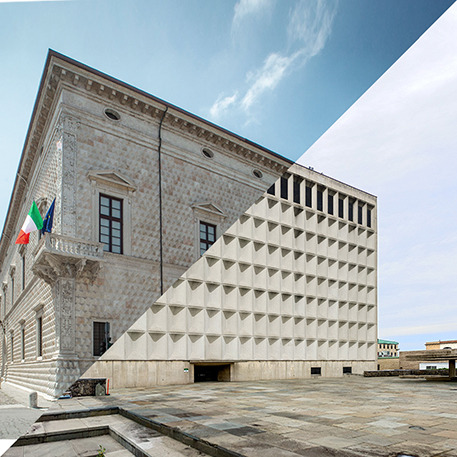
Biagio Rossetti, Palazzo dei Diamanti, Ferrara, Italy, 1493-1503 VS Marcel Breuer, Tech II, New York University, New York, USA, 1956-1961
#biagio rossetti#addizione erculea#ferrara#italy#italia#renaissance#rinascimento#estensi#Ercole I d'Este#Sigismondo I d'Este#Quadrivio degli Angeli#marcel breuer#new york#nyc#ny#usa#new york university#tech ii#diamond
43 notes
·
View notes
Text
The House of Borgia: End of a Dynasty (Part 4)
| Part 1 | Part 2 | Part 3 | References |
While the Conclave elected Pope Pius III, Cesare was occupied trying to find allies. His old friend, King Louis XII, came to his aid, issuing a statement to Romagna that their Duke was "alive and well and the friend of the King of France". Not only Cesare had the French's support, but he also counted on Ferrara's troops to protect his claim on Romagna, as Lucrezia had persuaded her husband and father-in-law to fight in her brother's defence.
Once Romagna was relatively stable and Cesare felt better, he returned to Rome, where he met with Pius III and had his position as Captain confirmed. Not only that, but due to Cesare's clever theft of the Papal Treasury, Pius III was left financially dependent on him. By all accounts, Cesare's life would continue on exactly as it had under Rodrigo's papacy.
Unfortunately for Cesare, Pius III died twenty six days after being elected Pope. The next Pope, Julius II, had been an old enemy of Rodrigo, and upon his election, was swift to force the Borgias to surrender their lands in Romagna, even ordering the new Captain of the Papal Forces to arrest Cesare when he refused to comply.
After Cesare's arrest, Julius decided to put him on trial and encouraged those wronged by him to file claims for financial compensation. Not only that, but Julius also charged Cesare with the murder of two cardinals, whose deaths were believed to have been arranged by Rodrigo. These trials never occurred, as in April 1503, Cesare was released in exchange for his remaining territories in Romagna. Once free, he departed for Naples, which was under Spanish rule and where the rest of the Borgias had taken refuge, with the exception og Lucrezia, who remained with her husband in Ferrara. Hardly had Cesare set foot in Naples when he was imprisoned again, as King Ferdinand of Spain wished to hand Cesare back to Julius II in exchange for an alliance against the French.
Cesare would remain imprisoned in Spain until 1506, when he managed to escape prison and seek refuge with his brother-in-law, Juan d'Albret, King of Navarre. Taking advantage of a civil war wrecking through Navarre, Cesare offered his services as a military leader to help King Juan reclaim the kingdom. This would prove to be Cesare's downfall, as on 12 March 1507, he was killed in battle by the revolting troops.
Six weeks would pass until the news of his death reached Lucrazia, who was, by this point, the Duchess of Ferrara. It's said that upon learning of her brother's fate, she locked herself in her room and began to wail his name. In 1508, Lucrezia would finally give birth to a son by d'Este, named Ercole II, who would be followed by Ippolito in 1509, Leonora in 1515, Francesco in 1516 and Isabella Maria in 1519. This last birth proved itself to be terribly complicated and claimed the lives of both mother and daughter.
Rodrigo, due to being a pope, was given a tomb in the Basilica di San Pietro, near his uncle's resting place. In 1586, Rodrigo's bones were dug up and placed on a casket alongside Alfonso's, which, in 1610, was taken to Santa Maria in Monserrato degli Spagnoli, where the casket was set aside and forgotten about until 1864, when it was unexpectedly found. It would take until 1889 for the joined remains to be once again given a proper tomb, with a stone memorial being carved in honour of Alfonso and Rodrigo.
Cesare was buried in a tomb by Juan d'Albret in the church of Santa Maria of Viana, in front of the high altar. His tomb, however, was destroyed by the bishop of Calahorra some time later, with Cesare's body being dumped in a hole outside the church. In 1945, the remains were exhumed and an autopsy was performed. The remains then bounced from place to place until finally being reburied in the church in 2007.
Lucrezia, meanwhile, was buried in Monastero del Corpus Domini, in Ferrara, alongside the other Dukes and Duchess of Ferrara. In time, Alfonso d'Este joined her, as did her children and grandchildren
Thus, the era of Borgia dominance came to a close. Although the family continued to hold titles in the subsequent years (most notably, Rodrigo's great-grandson, Francis Borgia, was canonized as a saint) they never reclaimed the formidable power they once commanded during Rodrigo's papacy. Yet, Rodrigo, Cesare, and Lucrezia did not fade into obscurity. Their legacy endured, capturing the public imagination for centuries to come. Indeed, as the chronicles of their lives spread through the courts of Europe, their reputation grew, blending reality and legend. Their lives continue to fascinate audiences, inspiring countless reinterpretations in literature, drama, and visual media even to this day.
4 notes
·
View notes
Text

Alfonso II d'Este (1533–1597), Duke of Ferrara
Artist: Italian (Ferrarese) Painter (late 16th century)
Date: Late 16th century
Medium: Oil on canvas
Collection: Metropolitan Museum of Art, New York City, NY, United States
Alfonso II d'Este
Alfonso II d'Este (22 November 1533 – 27 October 1597) was Duke of Ferrara from 1559 to 1597. He was a member of the House of Este.
Alfonso was the elder son of Ercole II d'Este and Renée de France, the daughter of Louis XII of France and Anne of Brittany and was the fifth and last Duke of Ferrara.
As a young man, Alfonso fought in the service of Henry II of France against the Habsburgs. Soon after his accession, he was forced by Pope Pius IV to send his mother back to France due to her increasingly Calvinist beliefs. The 1570 Ferrara earthquake occurred during his reign. In 1583, he allied with Emperor Rudolf II in the war against the Turks in Hungary.
Throughout the 1550s, Alfonso had an interest in Castrato singing voices. Given his childless marriages, this additional fact has prompted some historians to speculate that the Duke was homosexual.
#portrait#man#alfonso ii d'este#house of este#costume#three quarter length#italian painter#painting#oil on canvas#artwork#16th century painting#european art#italian nobility#italian culture
5 notes
·
View notes
Text

TÍTULO: Cabeza de San Juan Bautista AUTOR: Giovan Francesco Maineri FECHA: 1502 MATERIAL Y TÉCNICA: Óleo sobre tabla DIMENSIONES: 44x30 cm INVENTARIO: 5503
La obra llegó a Brera en 1921 procedente de la iglesia de Casatenovo (Lecco), a la que fue donada por un coleccionista milanés, pero sus orígenes se remontan a la zona de Romaña. El pequeño lienzo probablemente tenga un origen ilustre, ya que fue encargado en 1502 por Ercole I d'Este para sor Lucia da Narni.
Un claro reflejo del prototipo perdido de Leonardo se ha observado ahora en la pintura de Brera, donde el cuello seccionado de la cabeza se muestra en muy estrecha relación con los dibujos anatómicos de Leonardo de alrededor de 1489-1490, aquellos en los que se realizan diferentes secciones en las varias alturas de las extremidades humanas para resaltar los haces de músculos, el esqueleto y los vasos. La pintura esbelta pero muy fina, la entonación clara y luminosa, la destreza con la que están plasmadas las vetas de la superficie de mármol sobre la que reposa la copa, son elementos que hacen pensar que la influencia que ejerció en el artista el arte de Ercole de Roberti (habiendo trabajado en Mantua y Ferrara), aunque con un posible préstamo tipológico de Leonardo.
Información e imagen de la web de la Pinacoteca de Brera.
1 note
·
View note
Text
CANTUS THURINGIA
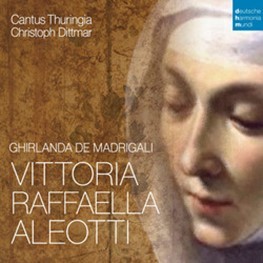
VITORIA ALEOTTI - GHIRLANDA DE MADRIGALI
El nuevo álbum del conjunto vocal Cantus Thuringia, junto con el clavecinista Bernhard Klapprott, da vida a los exquisitos madrigales de Aleotti. Disponible el 27 de septiembre.
Vittoria Raffaela Aleotti (c.1575-c.1646) fue una de las primeras mujeres compositoras y una de las principales personalidades musicales del siglo XVI, también conocida por sus habilidades como clavecinista, organista y directora de orquesta. Creció en la influyente corte musical de Este, en Ferrara, e ingresó en el convento de San Vito a los 14 años, donde continuó su educación musical. Más tarde, se convirtió en directora del convento de San Vito, cerca de su ciudad natal, Ferrara, y compuso hasta una edad avanzada, admirada, entre otros, por el duque Alfonso d'Este, el papa Clemente VIII y la archiduquesa Margarita de Austria.
Sus madrigales, de los que escribió el primero a los 16 años, se consideran una joya musical bien escondida. Con su refinamiento polifónico y su profundidad emocional, son un testimonio de su innovador estilo compositivo.
El nuevo álbum del conjunto vocal Cantus Thuringia, junto con el clavecinista Bernhard Klapprott, da vida a los exquisitos madrigales de Aleotti. Esta grabación no solo pone de relieve su notable talento, sino que también arroja luz sobre su importante contribución a la música del Renacimiento. El álbum supone un redescubrimiento de la obra de Aleotti, ofreciendo una interpretación fresca y vibrante que capta la esencia de su genio musical.
El conjunto vocal Cantus Thuringia se dedica al repertorio de los siglos XVI a XVIII en diversas formaciones: desde cuarteto hasta coro de cámara, los cantantes profesionales son capaces de crear un sonido de conjunto adecuado que se corresponda con la música. La colaboración con solistas de fama internacional amplía aún más su abanico musical. Además de centrarse en la música vocal sacra, el conjunto se esfuerza por lograr un concepto global unificado en la interpretación de obras escénicas mediante la colaboración con especialistas en interpretación histórica y gestual. Esto ha permitido al conjunto ganar atención internacional con producciones como “Dido y Eneas”, de Purcell (dirigida por Margit Legler), “Pimpinone”, de Telemann, y “Erwin und Elmire”, de Anna Amalia (ambas dirigidas por Nils Niemann). Dirigido musicalmente por sus fundadores Bernhard Klapprott y Christoph Dittmar, el conjunto actúa en festivales internacionales de renombre y ha producido numerosas grabaciones en CD, radio y televisión.
TRACKLIST
1 Ercole Pasquini (1560-1619) - Toccata in C Major 2 Vittoria Raffaella Aleotti (1575-1620) - Hor che la vaga aurora 3 Vittoria Raffaella Aleotti - Bacia per haver vita 4 Vittoria Raffaella Aleotti - O quante volta invan cor mio 5 Ercole Pasquini - Toccata in g Minor 6 Vittoria Raffaella Aleotti - T'amo mia vita 7 Vittoria Raffaella Aleotti - Io v'amo vita mia 8 Ercole Pasquini - Toccata in d minor 9 Vittoria Raffaella Aleotti - Cor mio perche pur piangi (Prima Parte) 10 Vittoria Raffaella Aleotti - Io piango (Seconda Parte) 11 Ercole Pasquini - Ruggieri in G Major 12 Vittoria Raffaella Aleotti - Dicesti anima mia 13 Vittoria Raffaella Aleotti - O dolce eterno amore 14 Luzzasco Luzzaschi - Canzon in F Major 15 Vittoria Raffaella Aleotti - Al turbar de' bei lumi 16 Ercole Pasquini | Vittoria Raffaella Aleotti - Canzon in a minor 17 Vittoria Raffaella Aleotti - Lasso quand'io credei 18 Vittoria Raffaella Aleotti - Per voi lasso 19 Ercole Pasquini - Primo tono in d minor 20 Vittoria Raffaella Aleotti - Mentre l'ardite labbia (Prima Parte) 21 Vittoria Raffaella Aleotti - Ahi che per altro (Seconda Parte) 22 Vittoria Raffaella Aleotti - Io dal sofferto foco 23 Ercole Pasquini - Toccata in A minor 24 Vittoria Raffaella Aleotti - Ahi che s'avien in me 25 Ercole Pasquini - Canzon in a minor II 26 Vittoria Raffaella Aleotti - Amor mio perche piangi 27 Luzzasco Luzzaschi (1575-1607) - Toccata in e minor 28 Vittoria Raffaella Aleotti - Ch'io non t'ami cor mio 29 Luzzasco Luzzaschi - Ricercare del secondo tuono 30 Vittoria Raffaella Aleotti - O dolc' anima mia 31 Luzzasco Luzzaschi - Ricercare del primo tuono 32 Vittoria Raffaella Aleotti - Se del tuo corpo (Prima Parte) 33 Vittoria Raffaella Aleotti - Pero Signor che vedi (Seconda Parte)
0 notes
Text
Prince of Foxes (1949).

"El príncipe de los zorros" o en su idioma original “Prince of foxes” no sitúa en la Italia del renacimiento a mediados de agosto de 1500, y no abre en un escenario de un velorio, el velorio de Alfonso de Aragón Príncipe de Salerno y esposo de Lucrezia Borgia es aquí donde nos muestran a los personajes principales de la trama, entre ellos al protagonista de la obra Andrea Orsini, un noble y aficionado al arte, el cual igual de habilidoso que es con el pincel lo es con las palabras y lleno de ambiciones, sirve como soldado al maquiavélico príncipe César Borgia el cual en la historia real es hijo del polémico Papa Alejandro VI y por ello ostenta tal poder. Durante esta primera escena vemos el buen trabajo hecho con la escenografía, la arquitectura representada siguiendo los cánones clásicos y tipologías propias de las iglesias del renacimiento sumándole la vestimenta de los actores ayudan a crea una experiencia inmersiva, intente encontrar información sobre el nombre de la misma iglesia, pero difícilmente pude encontrar nada más allá de la mención de que se la cinta se rodó en Italia y los las estructuras vistas en la misma son auténticas.
Dicho lo anterior proseguimos con la narrativa donde en poco tiempo nos muestran el objetivo principal Cesar Borgia donde selecciona a Andrea para llevar a cabo una intriga, esta misión consiste en arreglar el matrimonio de su hermana viuda, Lucrezia y a Alfonso d’Este, hijo del duque Ercole d'Este de Ferrara, dando a entender que la muerte de su cuñado fue ordenada por este mismo para sacarle provecho diplomático. Bajo esta escena nos muestran parte de la actitud del que posteriormente se nos presenta como protagonista de la obra, pero cuyas acciones y forma de pensar ya nos intuía este desenlace, gracias a ello Borgia eliminará a Ferrara como un impedimento para la conquista del centro de Italia y la posterior unificación de la península italiana.
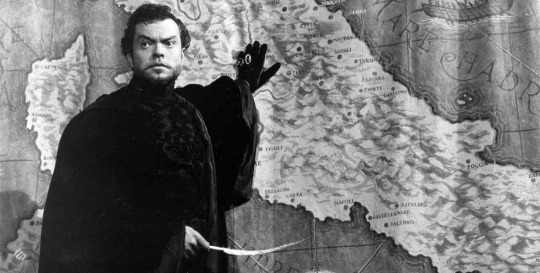
Andrea viaja a Venecia para vender algunos de sus cuadros y así recaudar dinero para los gastos de su misión, cabe resaltar que las imágenes que vemos son la real Venecia, tanto que se aprecia como existen la Campanile de San Marcos, Palacio Ducal de Venecia y el Palazzo della Librería (este último construido de entre 30 a 50 años después de la época donde nos situamos). Allí es donde conoce a otro personaje importante de la trama la cual señorita Camilla di Baglione, joven esposa del anciano conde Marc Antonio Varano de Citta del Monte. Durante su travesía a ferrara se nos muestra parte de la actitud de Andrea, un hombre confiado, carismático y bueno con el uso de las palabras tanto que convence a un asesino de contratarlo a pesar de que el mismo intento asesinarlo, además de mostrar dotes con el manejo de la espada. En ese mismo trayecto se detiene para visitar la granja de la viuda de un herrero. Ella es en realidad su madre, es aquí donde se nos muestra que el protagonista no es en realidad un noble si no un campesino y su nombre real es Andrea Zoppo y no el noble Orsini que pretende ser.
Al finalizar esta misión con éxito, se le encarga otra, esta vez una de asesinato donde su objetivo es la de embajador en la ciudad montañera de Citta del Monte (esta última existiendo solo en el universo de la cinta y cuya ubicación seria la actual San Marino), con órdenes de ayudar a Borgia a conquistar la ciudad en la cima de la montaña antes de la primavera, utilizando una conquista romántica de Camilla para facilitar el asesinato del anciano conde. Durante su estancia ocurren una serie de eventos que cambian la visión del protagonista mientras el amor hacia Camilla no hace más que aumentar y al mismo tiempo se ve cautivado por la sabiduría del hombre mayor y el amor por su pueblo.

El tiempo se agota y es donde llega Don Esteban, capitán de los ejércitos de Borgia para imponer sus condiciones a la ciudad. Es aquí donde Andrea Orsini despeja las dudas que durante meses se han ido acumulando en su cabeza y decide ayudar al Conde ante el ataque de las tropas de Borgia.
Durante un cruento asedio, el cual se sitúa en la actual Monte Titano en San Marino, el conde es herido de muerte en una emboscada, a partir de ahora el protagonista toma la defensa de la ciudad.
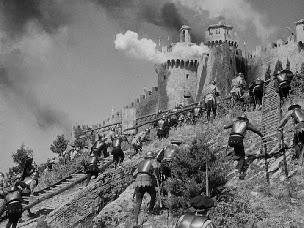
Después de tres meses de repeler los ataques, la ciudad se encuentra en sus últimas, aquí Orsini decide entregarse para que aceptar las condiciones de rendición y que la ciudad sobreviva, este es sentenciado a quedar ciego Belli, el asesino que se había vuelto su amigo es quien lo deja ciego con sus propias manos, pero es todo un truco para lograr salvar Andrea y finge la desfiguración, posteriormente juntos planean el rescate de Camila y junto a un levantamiento en la ciudad de Citta del monte logran liberarla, causando una resistencia en contra de la casa Borgia que culminaría con su caída. Finalizando esta obra con el casamiento del campesino Andrea Zoppo y Camilla di Baglione.
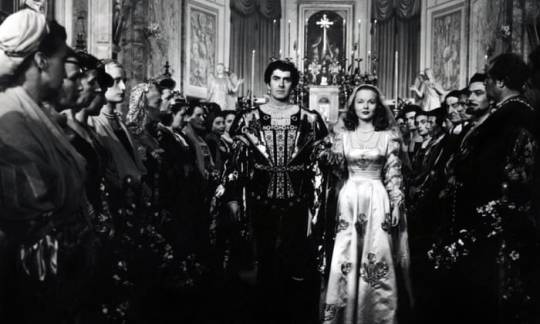
A lo largo de esta obra nos deja muy en claro lo complicado de los tiempos del renacimiento, una época llena de intriga, conspiraciones y guerras, el príncipe de los zorros nos trata de narrar desde un punto de vista algo fantasioso estos hechos, ya que, aunque en base se representa en sucesos reales, a partir de cierto punto de la trama sigue con la narrativa de la novela en la que se inspira originalmente la obra, siento que narra demuestra bien lo que podría ser a nuestros ojos el día a día de ese entonces, la presencia de obras de arte y frescos además de la utilería y las ropas te hace sentir que estas en la época a pesar de ciertas incongruencias históricas y las limitaciones de la misma época en la que se produjo. A pesar de la calidad de la cinta y el blanco y negro aun se logra preciar el paisaje de los montes italianos e incluso acompaña la narrativa de impresionantes coreografías de batallas donde combinan ese paso histórico entre lo medieval y la proliferación de la pólvora. La arquitectura también se lleva una porción del pastel a pesar de mostrar planos interiores la mayoría de las veces, la cinta nos muestra lugres emblemáticos Roma, San Gimignano, San Marino, Venecia y del Véneto.
0 notes
Text
Ludovico Ariosto, poeta del Rinascimento

Uno dei personaggi fondamentali della storia della poesia italiana… Ludovico Ariosto nacque a Reggio Emilia l’8 settembre 1474, il padre Niccolò era capitano della rocca della città e a causa dei suoi incarichi lavorativi impose alla famiglia una serie di spostamenti, prima a Rovigo nel 1481, poi a Venezia e Reggio ed infine a Ferrara nel 1484. Per volere del padre, Ludovico cominciò a studiare legge tra il 1484 e il 1494, oltre a frequentare la corte estense di Ercole I, dove venne a contatto con illustri personaggi dell'epoca tra cui Ercole Strozzi e Pietro Bembo. Gli anni più felici dell’ Ariosto furono quelli tra il 1495 e il 1500 quando poté occuparsi dello studio della letteratura, che è la sua vera passione. Il primo evento che sconvolse la vita di Ludovico fu la morte del padre nel 1500 dato che, come primogenito, doveva occuparsi delle sue cinque sorelle e dei quattro fratelli rimasti orfani. Nel 1502 accettò il capitanato della rocca di Canossa e li ebbe un figlio, Giambattista, nato dalla relazione con la cameriera Maria, seguito dopo poco tempo dalla nascita di un secondo figlio, Virginio, avuto dalla relazione con Olimpia Sassomarino. Ariosto nel 1503 prese gli ordini ecclesiastici minori ed entrò alle dipendenze del cardinale Ippolito d'Este, barcamenandosi tra incarichi amministrativi, servizi da cameriere personale, missioni politiche e diplomatiche. Tra il 1507 e il 1515 fu ad Urbino, Venezia, Firenze, Bologna, Modena Mantova e Roma, oltre ad essere impegnato nella stesura di L’Orlando Furioso e la scrittura e la messa in scena di alcuni lavori teatrali come le commedie Cassaria e I Suppositi. Nel 1510 il cardinale Ippolito ricevette una scomunica dal papa Giulio II e Ariosto andò a perorare la sua causa a Roma, ma non ebbe una buona accoglienza dal papa. Il poeta nel 1512 fuggì attraverso gli Appennini con il duca Alfonso, per sottrarsi alle ire papali, scatenate dall'alleanza tra gli Estensi e i francesi nella guerra della Lega Santa, poi andò a Firenze dove conobbe Alessandra Balducci, la moglie di Tito Strozzi, di cui si innamorò perdutamente. Dopo la morte del marito, avvenuta nel 1515, Alessandra si trasferì a Ferrara e tra i due ha inizio una lunga relazione che culminò in un matrimonio segreto nel 1527. Il rapporto tra Ariosto e il cardinale peggiorò a seguito della pubblicazione dell’Orlando Furioso nel 1516, poi Ludovico si rifiutò di seguire il Cardinale in Ungheria, dove fu nominato vescovo di Buda, e venne licenziato. Nel 1517 il poeta passò alle dipendenze del duca Alfonso d'Este e, dopo la riacquisizione da parte degli Estensi della Garfagnana, fu prescelto come governatore di quei territori dal 1522 al 1525 facendo il possibile per liberarli dai briganti che li infestano, dopodiché tornò a Ferrara. Ludovico visse i suoi ultimi anni di vita in completa tranquillità nella sua casetta di Mirasole, circondato dall'amore del figlio Virginio e della moglie Alessandra, oltre a dedicarsi alla revisione dell'Orlando Furioso, prima di morire il 6 luglio 1533, all'età di 58 anni. Read the full article
0 notes
Text
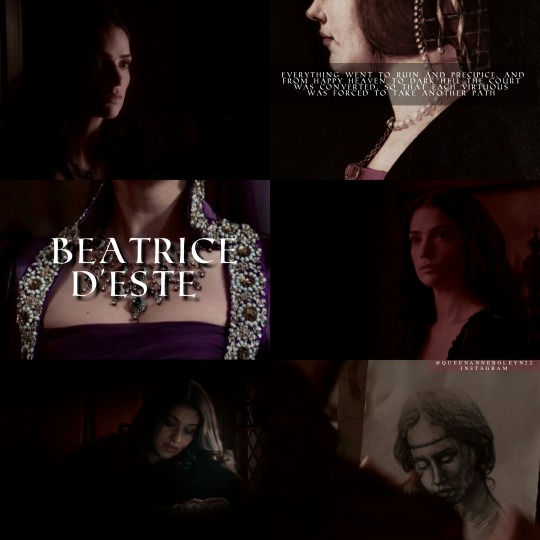
Beatrice d'Este (29 June 1475 – 3 January 1497), duchess of Bari and later of Milan, was the wife of the Milanese ruler Ludovico Sforza (known as "il Moro"). She was one of the most beautiful and accomplished princesses of the Italian Renaissance. A member of the Este family, she was the younger daughter of Ercole I d'Este and the sister of Isabella d'Este and Alfonso d'Este. Along with her sister, Beatrice was noted for her excellent taste in fashion and for having invented new clothing styles.
The Ferrarese house of Este and the Milanese house of Sforza had always been on friendly terms and in 1480, in order to cement an alliance, Ludovico Sforza formally asked Ercole d'Este to give him the hand of his daughter in marriage. Ludovico, who was then duke of Bari and regent to the duke of Milan, had originally requested a betrothal to Isabella, Beatrice's older sister, but because she was already promised to Francesco Gonzaga, Ercole offered him Beatrice instead. Il Moro made no objection to the arrangement and Beatrice was married to him in January 1491.The official nuptials were to have taken place in 1490 in a double wedding with Beatrice marrying Ludovico and Isabella marrying Francesco at the same time, but the Duke of Bari postponed it more than once. Finally, around a year later, they were wed in a double Sforza-Este wedding: Ludovico married Beatrice, while Beatrice's brother, Alfonso d'Este, married Anna Sforza, the sister of Gian Galeazzo Sforza. Leonardo da Vinci orchestrated the wedding celebration.
"A daughter was born this day to Duke Ercole, and received the name of Beatrice, being the child of Madonna Leonora his wife. And there were no rejoicings, because every one wished for a boy."
Beatrice had been carefully educated, and availed herself of her position as mistress of one of the most splendid courts of Italy to gather around her learned men, poets and artists, such as Niccolò da Correggio, Bernardo Castiglione, Donato Bramante, Leonardo da Vinci, and many others.In 1492 she visited Venice as ambassador for her husband in his political schemes, which consisted chiefly of a desire to be recognized as duke of Milan. On the death of Gian Galeazzo Sforza, Ludovico's usurpation was legalized, and after the Battle of Fornovo (1495), both he and his wife took part in the peace congress of Vercelli between Charles VIII of France and the Italian princes, at which Beatrice showed great political ability.
However, her brilliant career was cut short by death through childbirth, on 3 January 1497 at the age of 21. In a letter written hours after her death, Ludovico informed his brother-in-law Francesco Gonzaga that his wife, "gave back her spirit to God" half an hour after midnight. Their child had been born at eleven at night and was a stillborn son.
"And when Duchess Beatrice died," wrote the poet, Vincenzo Calmeta, "everything fell into ruin, and that court, which had been a joyous paradise, was changed into a black Inferno."
Beatrice d'Este belonged to the best class of Renaissance women, and was one of the cultural influences of the age; to a great extent, her patronage and good taste are responsible for the splendour of the Castello Sforzesco in Milan, the Certosa of Pavia, and many other famous buildings in Lombardy. Her tomb is preserved in the Certosa di Pavia where she is buried beside her husband Ludovico Sforza.
Her children by Ludovico Sforza:
-Massimiliano Sforza (25 January 1493 – 4 June 1530), duke of Milan 1512–1515.
-Francesco II Sforza (4 February 1495 – 24 October 1535), duke of Milan 1521–1535.
-Stillborn son (3 January 1497).
Source: "BEATRICE D'ESTE DUCHESS OF MILAN 1475-1497 A STUDY OF THE RENAISSANCE" BY JULIA CARTWRIGHT
"This duke had for his most dear wife Beatrice d'Este, daughter of Ercole, Duke of Ferrara, who, coming to Milan in the flower of her opening youth, was endowed with so rare an intellect, so much grace and affability, and was so remarkable for her generosity and goodness that she may justly be compared with the noblest women of antiquity. This duchess devoted her time to the highest objects. Her court was composed of men of talent and distinction, most of whom were poets and musicians, who were expected to compose new eclogues, comedies, or tragedies, and arrange new spectacles and representations every month. In her leisure hours she generally employed a certain Antonio Grifo"—a well-known student and commentator of Dante—"or some equally gifted man, to read the Divina Commedia, or the works of other Italian poets, aloud to her. And it was no small relaxation of mind for Lodovico Sforza, when he was able to escape from the cares and business of state, to come and listen to these readings in his wife's rooms. And among the illustrious men whose presence adorned the court of the duchess there were three high-born cavaliers, renowned for many talents, but above all for their poetic gifts—Niccolo da Correggio, Gaspare Visconti, and Antonio di Campo Fregoso, together with many others, one of whom was myself, Vincenzo Calmeta, who for some years held the post of secretary to that glorious and excellent lady. And besides those I have named there was Benedetto da Cingoli, called Piceno, and many other youths of no small promise, who daily offered her the first fruits of their genius. Nor was Duchess Beatrice content with rewarding and honouring the poets of her own court. On the contrary, she sent to all parts of Italy to inquire for the compositions of elegant poets, and placed their books as sacred and divine things on the shelves of her cabinet of study, and praised and rewarded each writer according to his merit. In this manner, poetry and literature in the vulgar tongue, which had degenerated and sunk into forgetfulness after the days of Petrarch and Boccaccio, has been restored to its former dignity, first by the protection of Lorenzo de' Medici, and then by the influence of this rare lady, and others like her, who are still living at the present time. But when Duchess Beatrice died everything fell into ruin. That court, which had been a joyous Paradise, became a dark and gloomy Inferno, and poets and artists were forced to seek another road."
"If in Isabella we have the supreme representative of Renaissance culture in its highest and most intellectual phase, Beatrice is the type of that new-found joy in life, that intoxicating rapture in the actual sense of existence, that was the heritage of her generation, and found expression in the words of a contemporary novelist, Matteo Bandello—himself of Lombard birth—when with his last breath he bade his companions live joyously, "Vivete lieti!" We see this bride of sixteen summers flinging herself with passionate delight into every amusement, singing gay songs with her courtiers, dancing and hunting through the livelong day, outstripping all her companions in the chase, and laughing in the face of danger. We see her holding her court in the famous Castello of Porta Giovia or in the summer palaces of Vigevano and Cussago, in these golden days when Milan was called the new Athens, when Leonardo and Bramante decorated palaces or arranged masquerades at the duke's bidding, when Gaspare Visconti wrote sonnets in illuminated books, and Lorenzo da Pavia constructed organs or viols as perfect and beautiful to see as to hear, for the pleasure of the youthful duchess. Scholars and poets, painters and writers, gallant soldiers and accomplished cavaliers, we see them all at Beatrice's feet, striving how best they may gratify her fancies and win her smiles. Young and old, they were alike devoted to her service, from Galeazzo di Sanseverino, the valiant captain who became her willing slave and chosen companion, to Niccolo da Correggio, that all-accomplished gentleman who laid down his pen and sword to design elaborate devices for his mistress's new gowns. We read her merry letters to her husband and sister, letters sparkling with wit and gaiety and overflowing with simple and natural affection. We see her rejoicing with all a young mother's proud delight over her first-born son, repeating, as mothers will, marvellous tales of his size and growth, and framing tender phrases for his infant lips. And we catch glimpses of her, too, in sadder moods, mourning her mother's loss or wounded by neglect and unkindness. We note how keenly her proud spirit resents wrong and injustice, and how in her turn she is not always careful of the rights and feelings of her rivals. But whatever her faults and mistakes may have been, she is always kindly and generous, human and lovable. A year or two passes, and we see her, royally arrayed in brocade and jewels, standing up in the great council hall of Venice, to plead her husband's cause before the Doge and Senate. Later on we find her sharing her lord's counsels in court and camp, receiving king and emperor at Pavia or Vigevano, fascinating the susceptible heart of Charles VIII. by her charms, and amazing Kaiser Maximilian by her wisdom and judgment in affairs of state. And then suddenly the music and dancing, the feasting and travelling, cease, and the richly coloured and animated pageant is brought to an abrupt close. Beatrice dies, without a moment's warning, in the flower of youth and beauty, and the young duchess is borne to her grave in S. Maria delle Grazie amid the tears and lamentations of all Milan. And with her death, the whole Milanese state, that fabric which Lodovico Sforza had built up at such infinite cost and pains, crumbles into ruin. Fortune, which till that hour had smiled so kindly on the Moro and had raised him to giddy heights of prosperity, now turned her back upon him. In three short years he had lost everything—crown, home, and liberty—and was left to drag out a miserable existence in the dungeons of Berry and Touraine.
#anna sforza#ercole d'este#d'este#beatrice d'este#janet montgomery#italian history#italian renaissance#rinascimento#leonardo da vinci#ludovico il moro#ludovico sforza#perioddramaedit#history#edit#history edit#ferrara#donne della storia#donne nella storia#renaissance italy#donne italiane#women of renaissance#renaissance#isabella d'este#alfonso d'este#15th century#duchess of bari#francesco gonzaga#vincenzo calmeta#gian galeazzo sforza#renaissance women
65 notes
·
View notes
Photo


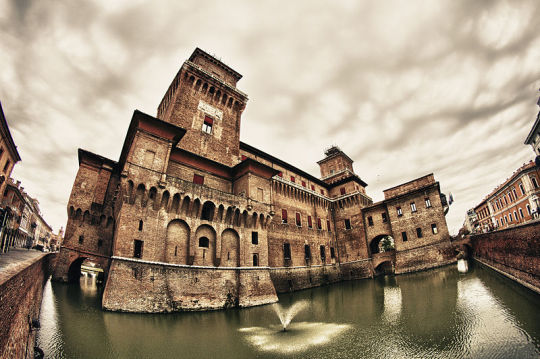
“ But a few days afterwards, while Duke Ercole was away from Ferrara, his wife was surprised by a sudden rising, the result of a deep-laid conspiracy, secretly planned by his nephew, Niccolo, a bastard son of Leonello d'Este. Niccolo's first endeavour was to seize on the person of the duchess and her young children, an attempt which almost proved successful, but was fortunately defeated by Leonora's own courage and presence of mind. The palace was already surrounded by armed men, when the alarm reached the ears of the duchess, and, springing out of bed with her infant son in her arms, followed by her two little daughters and a few faithful servants, she fled by the covered way to the Castello. Hardly had she left her room, when the conspirators rushed in and sacked the palace, killing all who tried to offer resistance. The people of Ferrara, however, were loyal to their beloved duke and duchess. After a few days of anxious suspense, Ercole returned, and soon quelled the tumult and restored order in the city. That evening he appeared on the balcony of the Castello, and publicly embraced his wife and children amid the shouts and applause of the whole city. The next day the whole ducal family went in solemn procession to the Cathedral, and there gave public thanks for their marvellous deliverance. A terrible list of cruel reprisals followed upon this rebellion, and Niccolo d'Este himself, with two hundred of his partisans, were put to death after the bloody fashion of the times. “- Julia Cartwright, Beatrice d'Este, Duchess of Milan, 1475-1497
#Leonora of Aragon#Eleanor of Naples#Eleonora d'Aragona#Ercole d'Este#Duchess of Ferrara#Duke of Ferrara#Italian history#Women in history#Men in history
8 notes
·
View notes
Quote
[...]when Lucrezia received a brief from her father supporting her claims for her allowance, and passed it on to one of Ercole's gentlemen for Ercole to read, he answered icily that he would not give way "even if God came to see us." Lucrezia's fury increased. It reached such a pitch that one day, when the Duke was paying her a customary call, she could not endure the irony of small talk any longer and burst out saying that it would have been better if the Duke had stayed at home to "settle his accounts."
The Life and Times of Lucrezia Borgia, Maria Bellonci
#lucrezia borgia#ercole d'este#auth: maria bellonci#lmaooo#my borgia princess#i'd have acted the same way#if not worse#i really love to see these moments where the borgias's patience and diplomacy runs out#and their spaniard blood speaks louder#and they just are painfully honest and ironic in their remarks#it's like their masks coming off for a bit you know
6 notes
·
View notes
Photo
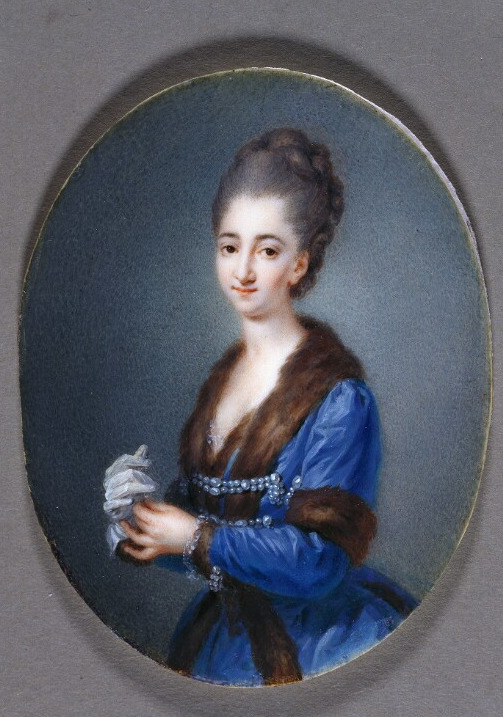
A miniature of Maria Beatrice d'Este, Duchess of Massa. She was born on this day, April 7th, in 1750. She was the only surviving child of Ercole III d'Este, Duke of Modena and Reggio, and Maria Teresa Cybo-Malaspina, reigning duchess of Massa and princess of Carrara. As their only surviving child, she was heiress to both her parents titles, and was highly sought after as a bride.
Ultimately she was married to Archduke Ferdinand, one of the sons of Maria Theresa and Francis I. Their marriage created a new branch of the house of Habsburg Lorraine, the House of Austria-Este. The couple had ten children together, with 7 surviving to adulthood.
Maria Beatrice inherited her mother’s titles as sovereign Duchess of Massa and Carrara when she died in 1790, but her father’s titles would pass to her eldest son Francis, since Modena and Reggio didn’t allow female succession. She died in 1829, and her titles then also passed to her son.
#maria beatrice d'este#Maria Teresa Cybo-Malaspina#Ercole III d'Este#archduke ferdinand#house of austria-este#long live the queue
55 notes
·
View notes
Photo

Ercole I d'Este - possibly by Dosso Dossi (1520-1530)
https://gallerie-estensi.beniculturali.it/en
#ercole i d'este#dosso dossi#painting#portrait#1500s#black#gallerie estensi#italy#high renaissance#renaissance#school of ferrara
0 notes
Text
The House of Borgia: The Rise and Fall of a Duke of Romagna (Part 3)
| Part 1 | Part 2 | Part 4 | References |
Cesare spent most of 1501 conquering territories throughout Romagna, leading a formidable army. It is important to note that when Rodrigo legalised these claims, he declared that Cesare had conquered and united those lands under the name of Borgia, not in the name of the Papal States and made Cesare into the Duke of Romagna. This established a hereditary dukedom for the Borgias, which could be passed down to the next generation.
Cesare's dukedom was in a precarious position and Rodrigo knew that. The best way to secure the Borgia control over Romagna was by getting Lucrezia a new husband, one that controlled lands near theirs. That potential husband was Alfonso d'Este, son and heir to the Duke of Ferrara. The primary obstacle was Ercole I d'Este, Alfonso's father, who opposed the marriage due to Lucrezia's controversial reputation. With the intervention of Louis XII, Ercole reluctantly agreed to the match. Yet, shortly after the engagement was announced, another scandal would circulate in the gossiping circles of Rome, proving that d'Este had been right in his worries. This scandal was the infamous Banquet of Chestnuts, held on 31 October 1501, and detailed in the journal of Johann Burchard, the Pope's Master of Ceremonies:
"Don Cesare Borgia gave a supper in his apartment in the apostolic palace, with fifty decent prostitutes or courtesans in attendance, who after the meal danced with the servants and others, fully dressed and then naked [...]. Chestnuts were strewn about, which the prostitutes, naked and on their hands and knees, had to pick up [...]. The Pope, Don Cesare and Donna Lucrezia were all present to watch. Finally prizes were offered to those men who fucked these prostitutes the greatest number of times."
There is much discussion regarding the historicity of the event, but regardless of how it may have occurred, it certainly wasn't like how it was portrayed in the episode 4 of season 3 of The Borgias, as Guilia Fernase, who is the organiser of the banquet in the episode was no longer involved with the Pope by 1501.
Despite the swirling rumours and scandals, Lucrezia's marriage to Alfonso d'Este moved forward. The wedding took place by proxy on 30 December 1501, with Alfonso's brother acting as his representative during the ceremony. This means that although Lucrezia was legally married to Alfonso, she still had never met him. Only a month later, on 30 January 1502, days before Lucretia's arrival in Ferrara, was that she finally met the man she was married to.
Cesare and Rodrigo continued their conquest, ignoring Louis XII's request that the family avoid Florence, which was under the French King's protection. When Louis learned of Cesare's plans, he sent troops to help protect the city from the Borgia's army. Fearing a confrontation with Louis XII and a potential betrayal by his own commanders, Borgia fled from his camp in disguise and journeyed towards Milan, where Louis had temporarily established his court.
Before he got to Milan, however, he took a little detour to visit Lucrezia, who was pregnant and gravely ill in Ferrara. The siblings talked in a Valentian dialect, in such a way that no observer could quite figure out what was being said. After spending the night with Lucrezia, Cesare continued on his way to Milan, where he met Louis and the two talked and came to an agreement: Cesare could take Bologna if he stopped disturbing Florence; not only that, but Louis also would arrange for Cesare's daughter, Louise, to marry the son (and heir) to Marquis of Mantua, who so happened to be the son of Lucrezia's sister-in-law (Lucrezia was married to Alfonso, whose sister Isabelle was married to the Marquis).
Lucrezia, meanwhile, was still ill and had given birth to a stillborn child. Cesare visited her again after he left Louis' court, while Lucrezia still laid on her bed and everyone was unsure if she would survive. This visit marked the last time they saw each other, though not due to the death of either Lucrezia or Cesare.
After leaving Lucrezia, Cesare returned to his campaign, where growing dissatisfaction among his generals led to treacherous plots. Despite that, Cesare outmanoeuvred his enemies and managed to maintain control of the Romagna region. Towards the end of 1502 and beginning of 1503, Cesare's war tactics became erratic and he stopped following his father's wishes. Many political machinations were also happening around this time, with Rodrigo trying to deceive the French, the Spanish and the Venetians.
As such, during the summer months of 1503, when Rodrigo and Cesare went to a party and, afterwards, both fell ill, rumours of poisoning quickly spread like wildfire. More scandalously, it was being said that they had been poisoned while trying to poison the other Cardinals. Nowadays, it's widely assumed that he died of malaria, which Cesare had likely also contracted.
Whatever might have been the cause of the illness, on 18 August, Rodrigo died while, Cesare himself struggled to survive. In the many plans that the Borgias had elaborated on how to remain in control after Rodrigo's death, never had it occurred to them that Cesare might be unavailable to go ahead with the plans. Had Cesare been healthy, he could have influenced the election of the next pope, maintained his position in the Papal Army, or even attempted to take the papacy for himself. Ultimately, the Borgia family's ambition to establish a hereditary papacy and create a united Italy had fallen apart.
What Cesare did manage to do was reach the Papal treasury before anyone else and took as much money as he could carry. Meanwhile, Rome was on the brink of chaos due to rival factions vying for power and external threats from both the French and Spanish armies. Additionally, Cesare's authority in the Romagna was being challenged by various leaders, with many nobles seizing the opportunity to reclaim their occupied territories.
In the middle of this political chaos, the College of Cardinals needed to elect a new Pope. The first step was to remove Cesare Borgia from his Vatican apartment, which he refused to vacate unless the next pope retained him as Captain of the Papal Forces. The College agreed to the terms and so Cesare left Rome, being carried in a litter by his servants. Once he had left, the conclave convened and elected Pope Pius III.
3 notes
·
View notes
Text

Princess Teresa Pamphilj Cybo
Artist: Jacob Ferdinand Voet (Flemish, 1639 - 1689)
Title: Portrait of Princess Teresa Pamphilj Cybo
Genre: Portrait
Date: 17th Century
Medium: Oil on Canvas
Maria Teresa Cybo-Malaspina (29 June 1725 – 29 December 1790) was sovereign Duchess of Massa and Princess of Carrara from 1731 until her death in 1790. From 1780, she also formally held the title of Duchess consort of Modena and Reggio as the wife Ercole III d'Este.
#portrait#princess#princess teresa pamphilj cybo#18th century italy#jacob ferdinand voet#flemish painter#duchess of massa#princess of carrara#italian nobility#italian noblewoman
3 notes
·
View notes
Video
youtube
The Hilliard Ensemble / Josquin Desprez / Absalon, fili mi (attrib.) (Missa Hercules Dux Ferrariae. Motets, 2004)
Absalon, fili mi (attrib.) · · Paul Hillier : Missa "Hercules dux Ferrariae", Motets and chansons
#the hilliard ensemble#josquin desprez#absalon fili mi#Missa Hercules Dux Ferrariae#motets#classical#audio#2004#2000s#paul hillier#warner#1400s#1500s#soggetto cavato#Ercole d'Este I#cantus firmus#polyphonic#mass
1 note
·
View note
Photo
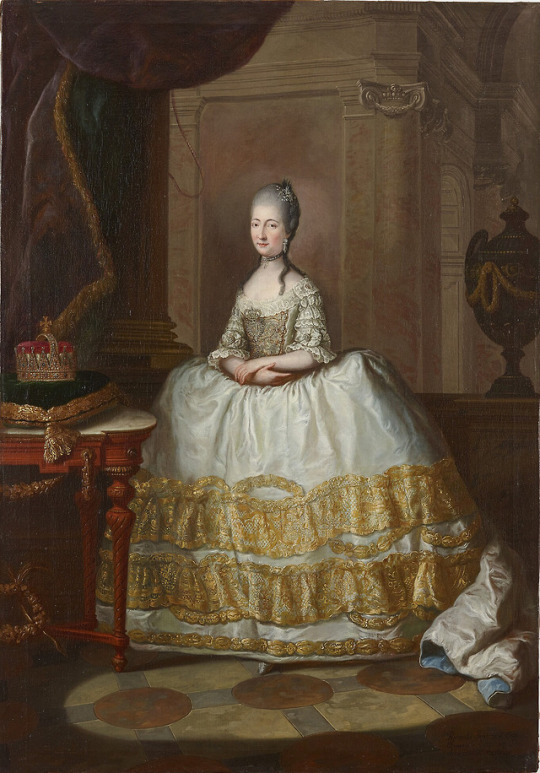
Maria Beatrice d’Este, Duchess of Massa (7 April 1750 - 14 November 1829)
#maria beatrice d'este#maria beatrice ricciarda#duchess of massa#daughter of ercole iii duke of modena#wife of ferdinand duke of breisgau#history#women in history#18th century#19th century#art
5 notes
·
View notes